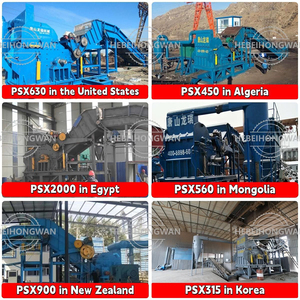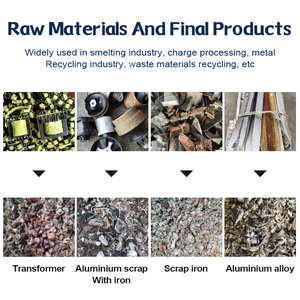
All categories
Featured selections
Trade Assurance
Buyer Central
Help Center
Get the app
Become a supplier

(1174 products available)



























Market Overview: The global market for scrap metal conveyors is poised for steady growth, aligning with the broader trends observed in the scrap metal shredders and automated material handling sectors. According to Research and Markets, the scrap metal shredders market grew from USD 36.42 billion in 2023 to USD 37.80 billion in 2024, with a projected CAGR of 6.01% to reach USD 54.83 billion by 2030. This indicates a robust demand for efficient material handling solutions, such as conveyors, which are integral to the processing and recycling of scrap metal. As industries increasingly focus on sustainability, the need for effective scrap metal management systems, including conveyors, has become essential for optimizing operations and reducing waste.
Regional Insights: The demand for scrap metal conveyors is particularly pronounced in regions experiencing rapid industrialization and eCommerce growth, such as Asia-Pacific and North America. In the U.S., the market for metal machining scrap equipment, which includes conveyors, was valued at approximately USD 1.7 billion in 2023, with expectations to reach USD 2.0 billion by 2030. The competitive landscape is characterized by key players investing in advanced technologies to enhance conveyor systems' efficiency and reliability. This trend is fueled by rising labor costs and a focus on streamlining operations, emphasizing the importance of automation in material handling. As manufacturers adapt to these market shifts, the integration of IoT and smart technologies in scrap metal conveyors is anticipated to further improve operational efficiency and safety.
As the demand for recycling and proper waste management systems grows, the importance of scrap metal conveyors increases in various industries around the globe. Different types of scrap metal conveyors exist for handling distinct kinds of metals, scrap metal pieces, and specific machinery configurations for the recycling operation. Here are some of the most common types of scrap metal conveyors.
Magnetic Scrap Metal Conveyors
Magnetic conveyors use a strong magnetic force to hold metal parts and move them through the system. They are suited to transport scrap metals of many shapes and sizes, including those with holes, notches, and internal features, as well as furreds, which makes them suitable for various applications. Magnetic conveyors have many advantages, such as removing undesirable items from the processed goods, ensuring the right pieces are located in the right places, minimizing the need for human labor, and reducing handling costs. In some situations, they can also reduce the number of conveyors in a processing line.
Chain Scrap Metal Conveyors
Chain conveyors are suitable for heavy-duty and high-temperature applications. They can handle multiple loads, including huge scrap metal pieces and weights, and have a long service life, making them ideal for heavy-duty applications. Heavy chain scrap metal conveyors also feature durable materials that withstand tough working environments and higher temperatures. Scrap metal chains are flexible. They can be used in various industrial sectors and can be customized according to the specific requirements of the conveyor system.
Magnetic Drum Conveyors
A magnetic sorter drum conveyor is an efficient device that separates ferrous materials from non-ferrous substances using a fixed magnetic field. It can be naturally integrated into scrap metal conveyor systems to enhance the purity of the final product. Such conveyors also help technicians by making their job easier and reducing labor costs.
The scrap metal conveyors specifications are determined according to the type of machine and what is generally known. The length can be changed completely up to 10m, and the width of metal scrap is generally between 0.5m and 1m. The weight capacity depends very much on the conveying method, with vertical conveyors capable of carrying between 5000kg and 20000kg per hour, while horizontal conveyors can carry 50000kg to 100000kg.
When it comes to maintenance, the most important thing is to take care of the required lubrication, which varies from machine to machine. The often necessary oiling points are:
Before starting the machine, it must be ensured that:
Conveyor belts are useful in a variety of industries. They can be twisted and turned to fit around any facility. Below is a list of some industries where scrap metal conveyors are useful:
Foundry industry
The foundry industry relies on scrap metal conveyors to transport hot metal. They carry molten metals from a furnace to a forming mold or carry scrap metals for sorting. Such tasks need robust conveyors that can take up to 1,000°F or 538°C. Moreover, the belts must resist oil, water, and chemical spills. Therefore, metal belts with ceramic or chrome are ideal as they can resist extreme temperatures. Molybdenum disulfide is another material that cools down temperatures quickly.
Mining industry
A heavy-duty scrap metal conveyor belt that can withstand the weight of metal ores is crucial in the mining industry. Metal ore weighs heavier than average metals. Therefore, miners use high-strength belts with impact-resistant carcasses and rubber overlays. Mining sites are rough and rugged, and the conveyors must withstand wear and tear. Therefore, it is crucial to use belts made with high-abrasion rubber.
Construction industry
In the construction industry, conveyors are helpful in screening and stockpiling scrap metal from demolition projects. They are also useful in material recovery facilities when separating construction waste from recyclable materials. Because demolition projects are exposed to so many dust particles, solenoids, sensors, and separators with dust-tight enclosures are critical. Dust suppression systems are also necessary to keep the infrastructure healthy and functioning. Inspecting belts in construction when there is dust is also critical as it can wear the equipment over time.
Recycling industry
In the recycling industry, conveyors help transport metal parts from discarded appliances, vehicles, and electronic devices. They help in the easy sorting of scrap metal, which is the first step in recycling. Different types of conveyors can help sort items. For example, a vibrating feeder conveyor belt is helpful in segregating metals by weight and size. However, it works well with ferrous metals. For non-ferrous metals like aluminum, copper, brass, and stainless steel, an eddy current separator is ideal. Motors drive them at high speeds, generating an electromagnetic field. It repels non-ferrous metal objects, which then flip and fall into designated containers.
The appropriate scrap metal conveyors may be selected by taking demand, application, and other aspects into account, which has fruitful benefit for both sides.
Conveying capacity and length
The selected conveying capacity and length should match the processing capacity of the entire scrap metal recycling line. Evaluate the handling volume per unit of time required and select the appropriate conveyor with a corresponding capacity and length to meet the handling requirements.
Material and design
Choose the appropriate material and design of the conveyor belt according to the characteristics of the scrap metal. Different types of materials and designs are suitable for handling different types of metals, such as smooth belts, tooth profiles, etc.
Motor power and drive mode
Select the appropriate driving model and motor power according to the handling capacity and the weight of the conveyed material. Ensure that the motor power can meet the operating requirements and that the transmission form can provide stable power output.
Site suitability
Consider the applicable environment on-site, including factors such as operating temperature, humidity, and the presence of dust. Choose appropriate scrap metal conveying equipment to ensure its performance and reliability in the specific environment.
Cost-effectiveness
Through market research and comparison, select the scrap metal conveyor that has the best cost performance, which can satisfy the project's requirement and at the same time, economically.
Q1. How long can a scrap metal conveyor last?
A1. The average lifespan of a conveyor belt is around 10 to 15 years. Conveyors with robust build materials, like manganese steel, have longer lifespans and can last up to 20 years or more with regular maintenance.
Q2. What are some recent trends in conveyor belts?
A2. Nowadays, scrap metal belts are being integrated into IoT systems for remote monitoring and predictive maintenance capabilities. More users prefer the modular plastic conveyors due to their flexibility and ease of maintenance. Environmental regulations are encouraging industries to adopt conveyors that optimize material recovery and recycling processes. This has included the effective separation of different types of metals to enhance recycling efficiency.
Q3. Do conveyors need a source of electricity?
A3. Only the operating type needs to be connected to an electric supply for the scraps to pass through the different automated sorting facilities. Manually operated conveyors do not require any electricity.
Q4. Can conveyors be recycled?
A4. After a scrap metal conveyor has been decommissioned, it can be taken apart and the pieces sorted. Metals like steel and aluminum can be sold to recycling facilities for remelting and refinement. The plastic components can also be recycled if there is a suitable facility that can process them.